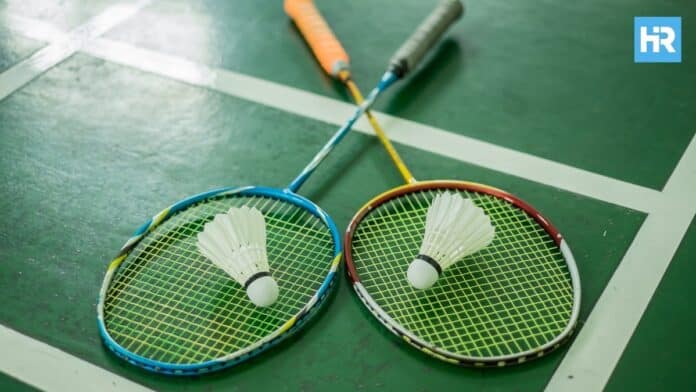Badminton is a fun and exciting sport that people play all over the world.
It’s simple to start playing, but like any skill, it takes practice to master, which makes it exciting for players of all levels.
In badminton, players use lightweight rackets to hit a shuttlecock over a net, trying to score points by landing it in their opponent’s court.
This guide will take you through everything you need to know about badminton—how it started, the rules, the equipment, and why so many people love it.
- Badminton evolved from “Poona,” a game played in India, and became a modern sport in England in 1873.
- It became an official Olympic sport in 1992, with a global following and prestigious tournaments like the BWF World Championships.
- Known for its speed and skill, badminton demands agility, quick reflexes, and tactical gameplay, with innovations like synthetic shuttlecocks and advanced scoring systems.
What is Badminton?
Badminton is an exciting and fast-paced sport that combines speed, skill, and strategy.
It’s one of the quickest racket games in the world, where players use lightweight rackets to hit a shuttlecock back and forth over a net.
The objective is to outsmart your opponent by landing the shuttlecock in their court or forcing them to make an error.
When it comes to speed, badminton is in a league of its own.
The shuttlecock, also called a “birdie,” is deceptively light—just about 5 grams—but it can rocket through the air at speeds exceeding 400 km/h.
The fastest smash ever recorded was a jaw-dropping 493 km/h, delivered by Fu Haifeng of China in 2005.
For context, that’s faster than most Formula 1 cars at top speed!
This makes quick reflexes and sharp anticipation critical for success.
Unlike sports with bouncing balls, badminton has zero room for error.
The shuttlecock doesn’t rebound, so each shot must be calculated and executed with pinpoint accuracy.
Players must position their rackets perfectly to keep the shuttlecock in play, whether defending against a smash or executing a delicate drop shot near the net.
In badminton, every move counts, and it’s also a mental workout.
The game demands strategic thinking as players constantly analyze their opponent’s moves, look for weaknesses, and decide whether to attack, defend, or set up their next shot.
Matches are filled with mind games, where split-second decisions can determine the outcome.
Physically, badminton is a full-body workout.
It builds agility, stamina, and core strength because players must sprint, leap, twist, and lunge across the court.
Professional players can cover up to 6 kilometers during a single match, often within 45 minutes!
One of the best things about badminton is its inclusiveness.
It’s a sport anyone can enjoy, whether you’re a child learning the basics, an adult playing for fitness, or a professional competing on the world stage.
It’s also easy to set up—no fancy equipment is needed for recreational play, just a racket, a shuttlecock, and a net.
That’s why badminton is a favorite at family gatherings, community centers, and schools worldwide.
The History of Badminton
Badminton has an interesting history that stretches back hundreds of years.
It started as a simple game in India and has grown into one of the world’s most exciting and popular sports.
Let’s take a closer look at where it came from and how it became the global sport we know today.
Ancient Roots in India
Badminton’s story begins in India with a game called “Poona” (also spelled “Poonah”), which was played in the 1800s.
It was named after the city of Pune, where it was very popular among British military officers.
The game was simple but unique—players hit a shuttlecock (a lightweight object made of feathers and cork) back and forth with wooden rackets.
Unlike other sports that used balls, the shuttlecock didn’t bounce, so players had to rely on skill to keep it flying.
When British officers returned to England, they brought the game with them.
In 1873, the Duke of Beaufort hosted a game at his estate in Gloucestershire called Badminton House.
The game became so closely linked with the estate that it was soon named “badminton.”
Setting the Rules
At first, badminton was mostly a fun activity played in backyards or indoors at parties.
But as more people started playing, there was a need for clear rules.
The Badminton Association of England (BAE) was formed in 1893, and it created the first official set of rules.
This made the game more structured and competitive.
Soon after, in 1899, the first major badminton competition was held: the All England Open Badminton Championships.
It quickly became one of the most important tournaments in the sport, and it’s still held today, attracting the best players from around the world.
Spreading Across the World
Badminton didn’t stay in England for long.
In 1934, nine countries formed the International Badminton Federation (IBF), the sport’s official governing body.
These founding members included:
- England
- Scotland
- Ireland
- Wales
- Denmark
- France
- The Netherlands
- Canada
- New Zealand
The IBF (now called the Badminton World Federation, BWF) helped spread the sport to more countries by organizing international tournaments and promoting the game worldwide.
A Place in the Olympics
Badminton became an official Olympic sport in 1992 at the Barcelona Games.
For the first time, the world could see just how fast and exciting badminton really was.
Players from Asia, in particular, stood out, with countries like China, Indonesia, and South Korea dominating the competition.
This recognition turned badminton into a global phenomenon, inspiring millions to pick up a racket.
The Countries Leading the Way
Since its inclusion in the Olympics, badminton has been ruled by a handful of countries that excel at the sport:
- China: A powerhouse with many world champions.
- Indonesia: Known for producing legendary players and thrilling performances.
- South Korea: Famous for its skillful doubles teams.
- India: Home to stars like P.V. Sindhu and Saina Nehwal.
- Denmark: The strongest European country in badminton, consistently challenging Asian dominance.
The Badminton Court: Where the Action Happens
The badminton court is, of course, where all the fun and excitement take place.
It’s designed with clear markings and specific measurements to make the game fair and enjoyable for everyone.
Let’s take a closer look at the court’s layout and details.
Court Dimensions and Layout
The badminton court is a rectangular space marked by lines that outline different areas for singles and doubles matches.
Here’s a breakdown of its dimensions:
- Length: The court is 13.4 meters (44 feet) long, which is the same for both singles and doubles matches.
- Width for Singles: The court’s width is 5.18 meters (17 feet) for singles play. This narrower space makes the game more challenging for individual players.
- Width for Doubles: In doubles, the court is wider at 6.1 meters (20 feet), giving teams more room to maneuver.
- Net Height: The net is 1.55 meters (5 feet 1 inch) tall at the posts and slightly lower in the center.
Important Parts of the Court
The badminton court is divided into specific sections, each with its own purpose.
These areas are clearly marked with lines that are 40 mm wide, typically white or yellow, for good visibility against the court’s surface.
Here’s what each area means:
- Baseline: The lines at the back of the court mark the furthest boundaries for both singles and doubles play. A shuttlecock landing outside this line is out of play.
- Sidelines: These mark the width of the court. The inner sidelines are used for singles, while doubles use the outer ones.
- Service Lines: These lines divide the court into sections for serving. Players must serve within their designated service box and send the shuttlecock into the opponent’s diagonal service box.
- Center Line: This runs perpendicular to the net, dividing the court into the left and right service courts.
The Net
The net is a critical feature of the badminton court, stretching across its width to divide it into two halves.
Made of a fine dark cord, the net has a mesh size of 15–20 mm, which ensures the shuttlecock can pass through without interference.
- Width of the Net: The net spans the full 6.1 meters (20 feet) of the court.
- Net Tension: It’s tightly secured at the posts to maintain height and position throughout the game.
Surface and Surroundings
The surface of a professional badminton court is typically made of wooden flooring covered with a specialized synthetic mat.
This mat gives players a good grip, reducing the risk of slipping during intense rallies.
The court should also have a clear space of 4 feet (1.3 meters) around its edges to allow players to move freely without hitting walls or obstacles.
Indoor Setup
Badminton is almost always played indoors, especially at competitive levels.
This is because the shuttlecock is very light—only about 5 grams—and can be affected by wind.
Playing indoors keeps the game fair by eliminating weather-related problems like wind or rain.
The Gear: Shuttlecocks, Rackets, and More
Badminton wouldn’t be the same without its gear.
As expected, everything, from the shuttlecock to the racket, is designed to make the sport fast and exciting.
Let’s break down the basics of the gear used in badminton.
Shuttlecocks
The shuttlecock, also known as the “birdie,” is the most important part of the game.
It’s what players hit back and forth, and it has a very unique design:
- Traditional Design: Early shuttlecocks were made from 16 goose feathers attached to a small cork base. Each feather had to be the same length to ensure the shuttlecock flew straight and evenly.
- Modern Shuttlecocks: Today, many shuttlecocks used in training or casual games are made of synthetic materials like nylon. These are stronger and last longer than feathered ones, making them great for regular use.
- Weight: A shuttlecock is incredibly light, weighing only about 5 grams. Even though it’s light, it can fly at incredible speeds.
Rackets
Badminton rackets have changed a lot over the years.
They’ve gone from heavy wooden rackets to lightweight, advanced designs that help players perform better.
- Early Rackets: The first rackets were made entirely of wood, which made them heavy and slower to swing. Players often wrapped cloth around the handles to make them easier to grip.
- Modern Rackets: Most rackets today are made from materials like graphite, carbon fiber, or aluminum. These light but strong materials make it easier for players to swing quickly and hit hard.
- Weight: A modern racket usually weighs between 70-100 grams, which is light enough for fast and accurate shots.
Features of a Racket:
- Strings: The racket’s strings are made of synthetic materials and strung tightly. Players can adjust the tension of the strings to suit their style. Tight strings give more control, while looser strings add power.
- Grip: The racket handle has a special grip that makes it comfortable and helps prevent slipping during the game. Players often add extra grip tape to customize it further.
Shoes and Clothes
Players also need the right shoes and clothing to move quickly and stay comfortable during the game.
- Shoes: Badminton shoes are lightweight and have non-marking soles, so they won’t leave marks on the court. They also provide good grip and cushioning to protect players’ feet and knees during quick movements.
- Clothing: Players usually wear light, breathable clothes that help keep them cool during intense games. Shirts and shorts made of moisture-wicking fabric are a popular choice.
Other Accessories
- Shuttlecock Tubes: Shuttlecocks are stored in round tubes to keep them in good shape. This protects the feathers (or synthetic material) and makes them last longer.
- Wristbands and Headbands: These help absorb sweat so players can stay focused on the game.
- Grip Tape: Some players add extra grip tape to their rackets for better control, especially during long matches.
How to Play: Rules and Scoring
Badminton might initially look complicated, but it’s pretty simple once you know the basics.
Let’s break it down step by step so you can play with confidence.
Scoring System
Badminton uses the rally point system, which has existed since 2006.
It’s a straightforward system and ensures that every rally counts.
Here’s how the scoring works:
- Match Format: A match is played as the best of three games. The player or team that wins two games first is the overall winner.
- Game Points: Each game is played to 21 points.
- Winning Margin: To win a game, a player or team must have a 2-point lead. For example, if the score is 20-20, the game continues until one side leads by 2 points (like 22-20).
- Maximum Points: If the score reaches 29-all, the first side to score 30 points wins the game, even without a 2-point lead.
Serving Rules
Serving is essential to badminton, and the rules ensure it’s done fairly.
Here’s what you need to know about serving:
- Underarm Serve: The serve must be hit underarm, and the shuttlecock must be struck below the server’s waist.
- Direction: The shuttlecock must travel diagonally across the net into the opponent’s service box.
- No Second Serve: Players don’t get a second serve like in tennis, so precision is important.
- Positioning:
- In singles, the server and receiver stand in the right service court for an even score (e.g., 0, 2, 4) and the left service court for an odd score (e.g., 1, 3, 5).
- The same rule applies in doubles, but players must rotate positions with their partner depending on the score.
Gameplay Rules
To keep the game fair and exciting, badminton has several important rules during play:
- Net Contact: During a rally, players cannot touch the net with their racket, body, or clothing.
- Shuttlecock Flight: The shuttlecock must not bounce. Once it hits the ground, the rally ends, and the point is awarded to the opposing side.
- Double Hits: A player cannot hit the shuttlecock twice in one attempt. This includes doubles matches, where partners can’t hit the shuttlecock back and forth before sending it over the net.
- In or Out: If the shuttlecock lands on the boundary line, it’s considered in. However, if it lands outside the court or doesn’t cross the net, the point goes to the opponent.
- Distractions: Players must not intentionally distract their opponents during play.
Timeouts and Breaks
Badminton includes short breaks to help players catch their breath and refocus:
- Between Games: Players get a 2-minute break between games.
- During a Game: A 90-second break is allowed when the leading side reaches 11 points in each game.
Famous Players: Legends and Stars
Badminton has a long history of incredible players who’ve left their mark on the sport.
Pioneers and Legends:
- Rudy Hartono: Won the prestigious All England Championships 8 times, a record that still stands today.
- Susi Susanti: Became Indonesia’s first Olympic gold medalist in 1992, inspiring a new generation of players.
- George Thomas: Founder of the Thomas Cup, the world’s premier team competition for men.
Modern Stars:
- Viktor Axelsen: A Danish powerhouse, he’s an Olympic gold medalist and a dominant force in the BWF World Tour Finals.
- P.V. Sindhu: A trailblazer from India with multiple World Championship medals and an Olympic silver medal to her name.
- Kento Momota: Known for his smart, strategic gameplay, the Japanese star has won numerous world titles.
The Best Tournaments Around
Badminton has some of the most exciting and famous tournaments in the world.
These competitions bring together the best players and teams, showcasing incredible talent, intense matches, and unforgettable moments.
Let’s explore the biggest badminton tournaments and why they are so important.
BWF World Championships
The BWF World Championships is considered the most prestigious individual tournament in badminton.
It is organized by the Badminton World Federation (BWF) and occurs yearly except during the Olympics.
This event allows the best players worldwide to compete for the title of World Champion.
The first World Championships took place in 1977 in Malmö, Sweden, and since then, it has grown to become one of the most anticipated events in the sport.
Winning gold at the World Championships is one of the highest honors for any player.
Legendary players like Lin Dan, P.V. Sindhu, and Viktor Axelsen have had unforgettable performances in this tournament, making their names synonymous with badminton excellence.
Thomas and Uber Cups
The Thomas and Uber Cups are the ultimate team competitions in badminton.
These tournaments embody national pride as countries compete for the top spot.
The Thomas Cup started in 1949 and is the men’s team championship.
It has been dominated by countries with a rich history in the sport, such as Indonesia, China, and Malaysia.
The Uber Cup, introduced in 1957, is the equivalent event for women’s teams.
China has been particularly dominant in this competition, winning the title more times than any other country.
The tournaments are held every two years and feature group stages and knockout rounds.
And it can’t be ignored that the atmosphere during these matches is electric, as players give their all for personal glory and their countries.
The Olympics
Badminton’s inclusion in the Olympics in 1992 was a major milestone for the sport.
It gave badminton global recognition and brought it to millions of new fans.
The Olympic Games are a platform where the best players from every corner of the world compete for the ultimate prize—an Olympic gold medal.
This event has given us some of the most memorable moments in badminton history.
In 1992, Indonesia’s Susi Susanti made history as the first Olympic badminton champion, which was a moment of great pride for her country.
Over the years, players like Chen Long, Carolina Marín, and Viktor Axelsen have delivered incredible performances, cementing their status as legends of the game.
For players, the Olympics represent the peak of their careers, and for fans, it’s a chance to see the very best go head-to-head.
Why Badminton Is Growing So Fast
Badminton’s popularity has exploded in recent years, and for good reason.
Here’s why:
- Easy to Start: Badminton doesn’t need expensive equipment or special facilities. A simple backyard, a net, a couple of rackets, and a shuttlecock are enough to start.
- A Sport for Everyone: People of all ages and skill levels can play badminton. It’s great for kids, adults, and even seniors looking for light exercise.
- Health Benefits: Playing badminton is a full-body workout. It improves cardio fitness, strengthens muscles, sharpens reflexes, and enhances hand-eye coordination.
- Global Reach: With over 339 million people playing badminton worldwide, the sport has a massive following. It’s particularly popular in Asia, where countries like China, Indonesia, and India regularly produce world-class players.
- Exciting to Watch: Badminton’s speed, strategy, and incredible athleticism make it a thrilling sport. The intensity of rallies and players’ skills keep fans glued to their screens.
A Sport That Connects People Worldwide
No matter where you’re from, what language you speak, or how good you are, badminton is a sport everyone can enjoy.
This sport is loved in many parts of the world, especially in places like China, India, Indonesia, and Denmark, but it’s also growing in other countries.
It’s easy to start playing and doesn’t need expensive equipment, so anyone can join in, whether they’re young or old, playing for fun or aiming to become a pro.
It’s a simple game with a big heart, proving that sports can unite us no matter where we come from.
So pick up a racket, gather your friends, and see how badminton can bring people closer, one game at a time.






